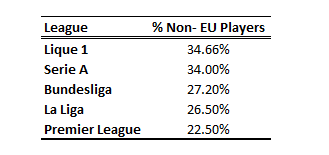 The EPL is Bottom of The List for Non-EU players
The EPL is Bottom of The List for Non-EU players On the 23rd of March Stefan Szymanski, a leading Sports Economist, offered his thoughts on how Greg Dyke (head of the FA) persuaded the English government to approve new rules on work permits for foreign players. It is important to note the motivation for the rule change by Greg Dyke is to improve the English national team and to allow more English-born players into top-flight clubs.
Szymanski maintains that “the policy of isolationism when faced with strong foreign competition almost never works”. I think few Economists would disagree with this sentiment. He also suggests that the rules may contravene EU law on the free movement of labour and predicts that the new rules will neither reduce the percentage of foreign players in the EPL nor improve the performance of the national team. I’d have to agree here too.
I have written about this general topic many times, a summary can be read here.
Here are some facts once again on the nationalities of 2,751 footballers from the start of this season in Europe (that is accurate up to the opening of the last transfer window).
1. As of the start of the 2014-2015 season to the 31st of December, the EPL had the lowest amount of Non-EU footballers (22.5%) when compared to the other big European leagues – Serie A (34%), Lique 1 (34.66%), Bundesliga (27.2%) and La Liga (26.5%).
2. Oppositely, the EPL has the highest percentage of players born in the EU (77.5%) when compared to the other Big 4 leagues, but has the lowest amount of national born players. The EPL has over double the number of footballers (231) from the EU but not from the country of the domestic league when compared to the other big four of Serie A (107), Bundesliga (102), La Liga (57) and Lique 1 (55).
If anything, players from within the EU are ‘the problem’, not those from outside. Looking at the aggregates, the EPL clubs adopt a model where about 25% of players come from outside the EU and the remaining 75% is split equally between national born players and those from other EU countries. The other Big 4 leagues adopt a similar model in terms of attracting non-EU talent but they differ from the EPL in that the players from the EU in Germany, France, Spain and Italy are predominantly from that country.
 RSS Feed
RSS Feed